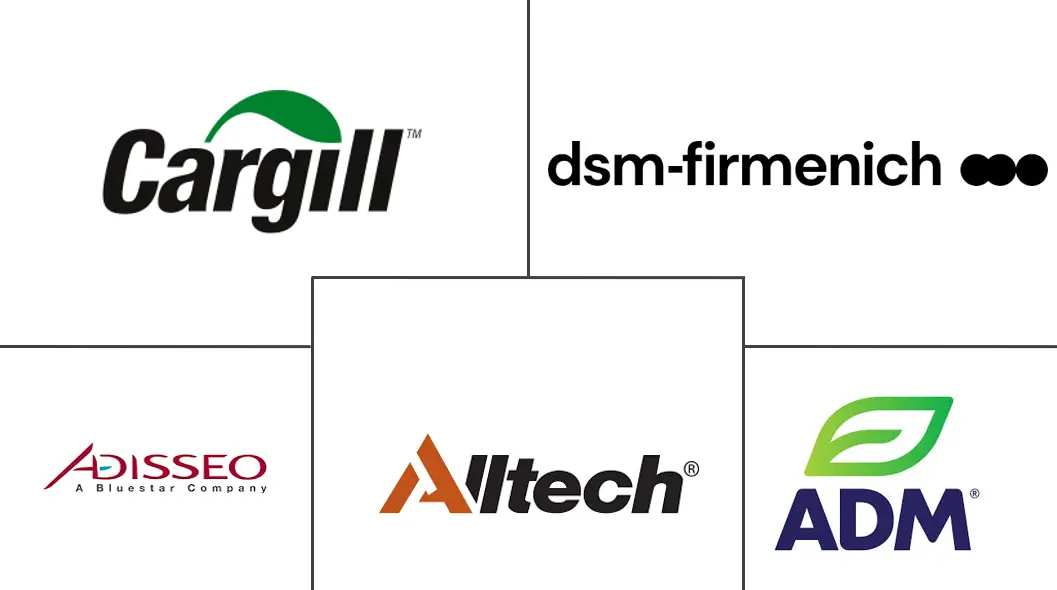Middle East Feed Additives Market Size and Share
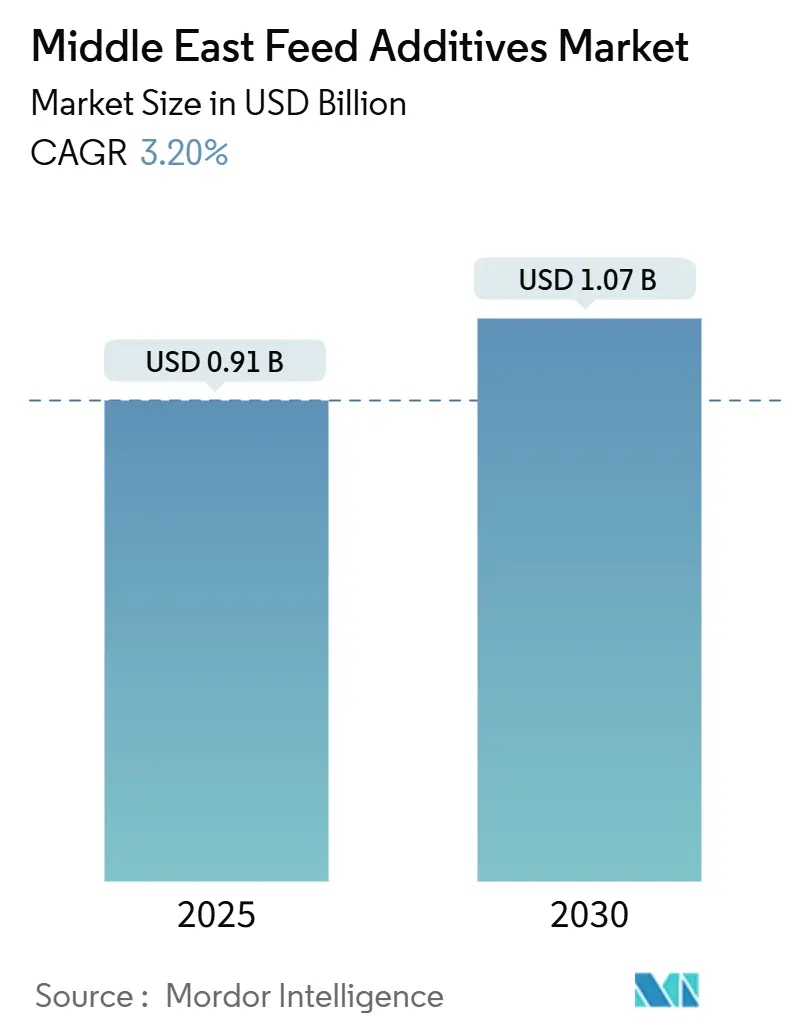
Middle East Feed Additives Market Analysis by Mordor Intelligence
The Middle East feed additives market size stands at USD 0.91 billion in 2025 and is forecast to reach USD 1.07 billion by 2030, advancing at a 3.2% CAGR. This measured expansion is anchored in national food-security frameworks, large-scale poultry and aquaculture projects, and a decisive regulatory move away from antibiotic growth promoters toward higher-value specialty inputs. Rising capital expenditure on modern housing that curbs heat stress, the shift to precision premixes, and sustained government investment in integrated feed and livestock complexes collectively support steady demand for amino acids, enzymes, and organic acids. Substitution of imported soybean meal with locally optimized protein diets further elevates inclusion rates of digestibility enhancers, while expanded grain-storage capacity stabilizes formulation consistency and encourages performance additives over rudimentary supplements. Although geopolitical freight risks and raw-material cost spikes occasionally disrupt supply chains, the structural push for livestock self-sufficiency keeps the Middle East feed additives market on a clear growth path.
Key Report Takeaways
- By additive, amino acids held 20.6% of the Middle East feed additives market share in 2024, whereas acidifiers are projected to record a 3.53% CAGR through 2030.
- By animal, poultry captured 55.7% revenue share in 2024, while aquaculture exhibits the fastest projected CAGR at 4.1% through 2030.
- By geography, Saudi Arabia led with 39.1% of the Middle East feed additives market size in 2024, while Iran is poised to expand at a 3.59% CAGR to 2030.
Middle East Feed Additives Market Trends and Insights
Drivers Impact Analysis
| Driver | (~) % Impact on CAGR Forecast | Geographic Relevance | Impact Timeline |
|---|---|---|---|
| Poultry‐sector expansion and government self-sufficiency targets | +0.8% | Saudi Arabia, UAE, and Iran | Medium term (2-4 years) |
| Regulatory shift away from antibiotic growth promoters toward specialty additives | +0.6% | Saudi Arabia, Iran, and Kuwait | Long term (≥ 4 years) |
| Rising feed mill modernization and premix demand | +0.5% | Saudi Arabia, Iran, and regional | Medium term (2-4 years) |
| Rapid aquaculture investments on Persian Gulf and Red Sea coasts | +0.4% | Saudi Arabia, UAE, and Oman | Long term (≥ 4 years) |
| Climate-adapted housing pushes demand for heat-stress-mitigating additives | +0.3% | Region-wide | Short term (≤ 2 years) |
| Halal-certified organic-acid blends gaining traction with export-oriented integrators | +0.2% | Saudi Arabia, UAE, and Qatar | Medium term (2-4 years) |
| Source: Mordor Intelligence | |||
Poultry‐sector expansion and government self-sufficiency targets
Large integrated producers are scaling output to meet food-security mandates. Balady Poultry’s plan to add 200 million chicks annually will lift demand for starter, grower, and finisher diets rich in amino acids, enzymes, and immune modulators. The top seven Saudi producers already control 87% of slaughter volumes, granting them procurement leverage that favors technically advanced additive partners. Similar state-backed expansion in the UAE and Iran reinforces a regional need for high-precision premixes that enhance feed-conversion ratios and shorten finishing cycles. As flock genetics improve and production densities rise, the Middle East feed additives market increasingly prioritizes digestibility enhancers and gut-health solutions over broad-spectrum antibiotics. Demand visibility is further supported by dedicated poultry-cluster zones that embed feed-mill, hatchery, and processing infrastructure in one location, aligning logistics with just-in-time additive supply.
Regulatory shift away from antibiotic growth promoters toward specialty additives
Antimicrobial-resistance concerns drive ministries of health and agriculture to curtail in-feed antibiotics. Saudi studies show that Bacillus subtilis combined with serratiopeptidase can match antibiotic growth-promotion effects, validating probiotic-enzyme alternatives in desert production systems. The Saudi Food and Drug Authority routinely updates its restricted-substances list, accelerating withdrawal timelines for critical antibiotics.[1]Source: Saudi Food and Drug Authority, “Regulations Exceptions List,” sfda.gov.sa Iran’s multi-agency approval pathway also now favors organic acids and phytogenics, although overlapping jurisdictions extend dossier reviews. Export-oriented integrators targeting European retail chains adopt certified alternatives to comply with stringent residue limits. This regulatory convergence lifts specialty additive inclusion rates, boosting the Middle East feed additives market.
Rising feed mill modernization and premix demand
Automated dosing, inline NIR scanners, and vacuum-coating systems are becoming standard in mills exceeding 1 million metric tons of annual output. ARASCO’s 4.5 million metric tons capacity and NAQUA’s twin-screw extrusion lines exemplify the scale that supports precise micro-ingredient delivery. Such facilities require premixes that maintain homogeneity at low inclusion rates, fostering demand for encapsulated vitamins, thermostable enzymes, and moisture-resistant probiotics. Suppliers with formulation software and on-site technical services gain share, reflecting a shift from commodity sales to integrated nutrition solutions. Modern storage assets, such as Saudi Arabia’s SABIL network, with 2.7 million metric tons of grain capacity, further stabilize base-ingredient quality and encourage higher-value additive use.
Rapid aquaculture investments on Persian Gulf and Red Sea coasts
Saudi Arabia targets 600,000 metric tons of annual aquaculture output by 2030, supported by public-private ventures in Ras Al-Khair and NEOM. Intensive shrimp and seabream systems employ functional additives, including attractants, immunostimulants, and omega-3 emulsions, that tolerate high salinity and temperature. NAQUA alone consumes more than 120,000 metric tons of marine feed per year, anchoring continuous orders for methionine, betaine, and water-stability binders. The Cargill-ARASCO-NEOM initiative stresses fish-meal replacement, elevating demand for lysine, threonine, and protease complexes that boost plant-protein digestibility. Regional hatcheries also import micro-diets coated with astaxanthin for pigmentation, widening the scope for natural carotenoid suppliers. These investments extend the Middle East feed additives market into specialized marine segments that command premium margins.
Restraints Impact Analysis
| Restraint | (~) % Impact on CAGR Forecast | Geographic Relevance | Impact Timeline |
|---|---|---|---|
| Volatile soybean/corn import prices inflate feed costs | -0.4% | Region-wide | Short term (≤ 2 years) |
| Fragmented distribution and late payments from smallholders | -0.3% | Iran and wider region | Medium term (2-4 years) |
| Geopolitical shipping risks through Red Sea raise additive lead-times | -0.2% | Saudi Arabia, UAE, and Egypt | Short term (≤ 2 years) |
| Limited regional lab capacity for mycotoxin and residue testing slows product approvals | -0.2% | Iran and wider region | Long term (≥ 4 years) |
| Source: Mordor Intelligence | |||
Volatile soybean/corn import prices inflate feed costs
Middle Eastern livestock producers import roughly 90% of their protein meals, exposing margins to Chicago Board of Trade swings, currency moves, and freight premiums. When soybean meal prices tripled during 2022 supply shocks, broiler integrators cut amino-acid inclusion rates or shifted to lower-specification blends, dampening additive demand. Currency pegs mitigate part of the volatility for Gulf producers, yet Iranian and Egyptian buyers face sharper cost spikes due to exchange-rate fluctuations. Government subsidy adjustments also transmit price signals quickly to downstream mills, curtailing discretionary additive purchases. This sensitivity narrows budgets for specialty inputs during adverse commodity cycles, hindering uptake in the Middle East feed additives market.
Fragmented distribution and late payments from smallholders
In Iran and parts of the Levant, thousands of small backyard farms operate outside formal credit channels, complicating distributor cash-flow management. Late payments extend beyond 120 days in some cases, increasing working-capital costs for additive resellers. Limited on-farm storage capacity forces frequent, low-volume deliveries, raising logistics expenses. Technical extension services remain scarce, so adoption of precision premixes lags behind major integrators. These structural inefficiencies restrain broad-based growth even as demand expands among corporate producers.
Segment Analysis
By Additive: Amino Acids Sustain Protein Efficiency Gains
Amino acids secured the largest slice of the Middle East feed additives market at 20.6% in 2024, reflecting a strategic push to maximize nitrogen utilization in diets dominated by imported soybean meal. Lysine, methionine, and threonine underpin performance in high-density poultry complexes where protein costs represent more than 60% of feed value. Evonik’s recent switch to 25 kg paper bags for MetAMINO aligns with regional sustainability goals and could become a procurement prerequisite for Gulf integrators.[2]Source: Evonik, “Animal Nutrition & Health: Sciencing the Global Food Challenge,” evonik.com Methionine demand further benefits from layer and breeder expansion that intensifies sulfur amino-acid requirements for eggshell and feather formation.
Acidifiers emerge as the fastest-growing additive segment at 3.53% CAGR through 2030, driven by regulatory restrictions on antibiotic growth promoters and proven efficacy in pathogen control and nutrient absorption enhancement. Enzymes enjoy robust uptake as mills adopt total-phosphorus reduction targets to ease environmental permitting. Phytase inclusion rates already reach 500 FTU/kg in several Saudi formulations, cutting dicalcium phosphate by 3–4 kg per metric ton. Carbohydrases and proteases follow, helping plants replace fish meal in marine diets. Probiotics and prebiotics receive further momentum from consumer preference for clean-label proteins and retailer bans on prophylactic antibiotics. Vitamins retain a stable share, vitamin E and vitamin C are routinely elevated in summer to offset oxidative stress. Mycotoxin detoxifiers, though niche, gain strategic interest as sorghum and barley imports from humid origins raise contamination risks. Collectively, these dynamics keep the additive category mix fluid and innovation-driven.
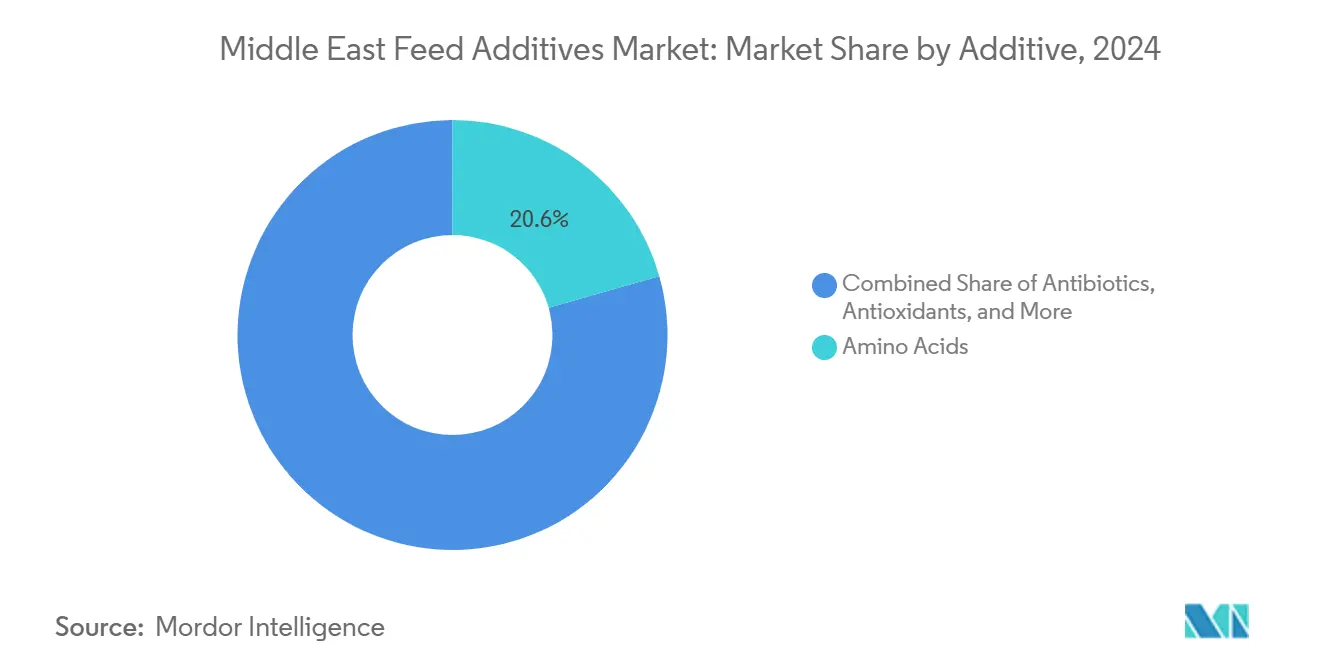
Note: Segment shares of all individual segments available upon report purchase
By Animal: Poultry Retains Primacy While Aquaculture Accelerates
At 55.7% revenue share in 2024, poultry remains the anchor of the Middle East feed additives market. Broiler operations produce the bulk of volumes, but layer farms also scale to meet domestic egg demand. Integrators such as Al Watania and Almarai coordinate feed-mill, hatchery, and processing functions, allowing seamless rollout of precision nutrition protocols. Inclusion of betaine, electrolytes, and antioxidant vitamins moderates heat-stress losses, especially during July–September periods when ambient temperatures top 45 °C. Breed genetics, denser housing, and shorter cycles likewise raise demand for enzymes and organic acids that maintain gut integrity.
The poultry segment is anticipated to register the highest CAGR of 3.37% through 2030. Aquaculture, though smaller, outpaces the overall market CAGR. Shrimp farming in Jazan and fish cages off Fujairah expand water-stable pellet demand fortified with attractants, nucleotides, and carotenoids. Functional feed trials financed under Saudi Arabia’s Blue Transformation plan report feed-conversion ratios below 1.4 when digestibility enhancers are paired with high-soy protein concentrates. Ruminant additive uptake remains stable, focused on rumen buffers, methane inhibitors, and fertility bolsters. Swine contribute little, while camels and small ruminants form niche pockets, particularly for electrolyte and vitamin boluses during transhumance seasons.
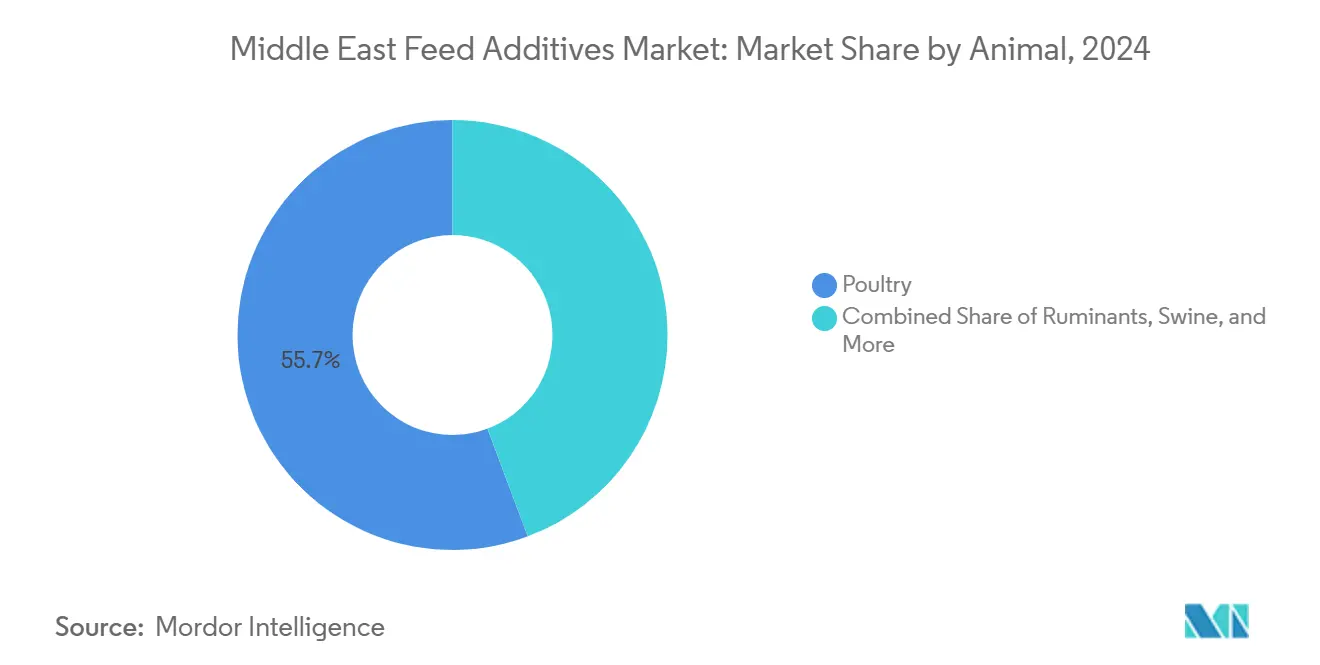
Note: Segment shares of all individual segments available upon report purchase
Geography Analysis
Saudi Arabia continues to anchor aggregate demand, producing more than 850 million broilers and 100,000 metric tons of shrimp annually. Government loan guarantees and soft-rate financing accelerate the installation of tunnel-ventilated sheds that rely on anti-stress additives, enzymes, and precision electrolytes. Clear SFDA import protocols give multinational suppliers confidence to launch advanced formulations quickly, lifting the Middle East feed additives market share of technology-rich products. Co-located mills near major poultry clusters minimize freight and enable just-in-time micro-ingredient deliveries, while strategic grain reserves stabilize feed quality.[3]Source: Saudi Food and Drug Authority, “Executive Management of Food Import Control,” sfda.gov.sa
Iran’s growth trajectory reflects macroeconomic reforms that liberalize foreign direct investment in feed milling and animal production. Domestic capacity additions approach 1.2 million metric tons per year, creating a sizable addressable market for amino acids, enzymes, and organic acids. Progressive curbs on antibiotic growth promoters accelerate probiotic registrations, although dossier reviews still span 12–18 months. Regional academic partnerships yield locally isolated Bacillus strains adapted to continental climate variability, grounding the additive supply chain in indigenous bio-resources.
The wider Middle East, spanning the UAE, Kuwait, Qatar, Oman, Bahrain, Jordan, and Lebanon, delivers incremental volume through premiumization. Consumers favor chilled native poultry over imports, pushing integrators toward flavor-modulating acidifiers and color-enhancing carotenoids. UAE free-zone hubs such as Khalifa Industrial Zone attract premix blenders who serve both local customers and re-export markets across South Asia and Africa. Oman’s RO 2 million (USD 5.17 million) investment in vitamin and additive manufacturing underscores a policy pivot toward domestic value creation. Geopolitical freight risks remain a shared concern, encouraging strategic stockholding and regional manufacturing alliances.
Competitive Landscape
The Middle East feed additives market is moderately concentrated. ADM, Cargill, Incorporated, Adisseo (BlueStar), DSM-Firmenich, and Alltech leverage technical service teams and regional warehouses to secure framework contracts with integrators. DSM-Firmenich’s divestiture of its enzyme alliance stake to Novonesis for EUR 1.5 billion (USD 1.6 billion) realigns competitive standings, positioning Novonesis as a dominant player with expanded Gulf distribution.[3] Phibro Animal Health’s acquisition of Zoetis’ medicated feed additive portfolio diversifies its offering into coccidiostats and water-soluble antibiotics, although future sales depend on evolving bans.
Regulatory mastery differentiates suppliers; manufacturers registered with stringent authorities gain faster SFDA clearance. Traceability platforms that integrate batch data into customer ERP systems add further value. Sustainability credentials, such as reduced-plastic packaging and verified carbon footprints, increasingly influence purchasing committees, especially at publicly listed regional processors. Local blend-and-pack ventures with Gulf Cooperation Council equity satisfy in-country value thresholds, granting tariff advantages and preferences in government tenders.
White-space opportunities center on heat-stress mitigants, halal-certified phytogenics, and mycotoxin detoxifiers tailored for sorghum and barley. Start-ups offering data-driven micro-dosing sensors can partner with established additive brands to deliver outcome-based nutrition programs. Competitive intensity remains moderate, with price competition limited by stringent quality and documentation requirements.
Middle East Feed Additives Industry Leaders
-
ADM
-
Alltech
-
Adisseo (BlueStar)
-
Cargill, Incorporated.
-
DSM-Firmenich
- *Disclaimer: Major Players sorted in no particular order
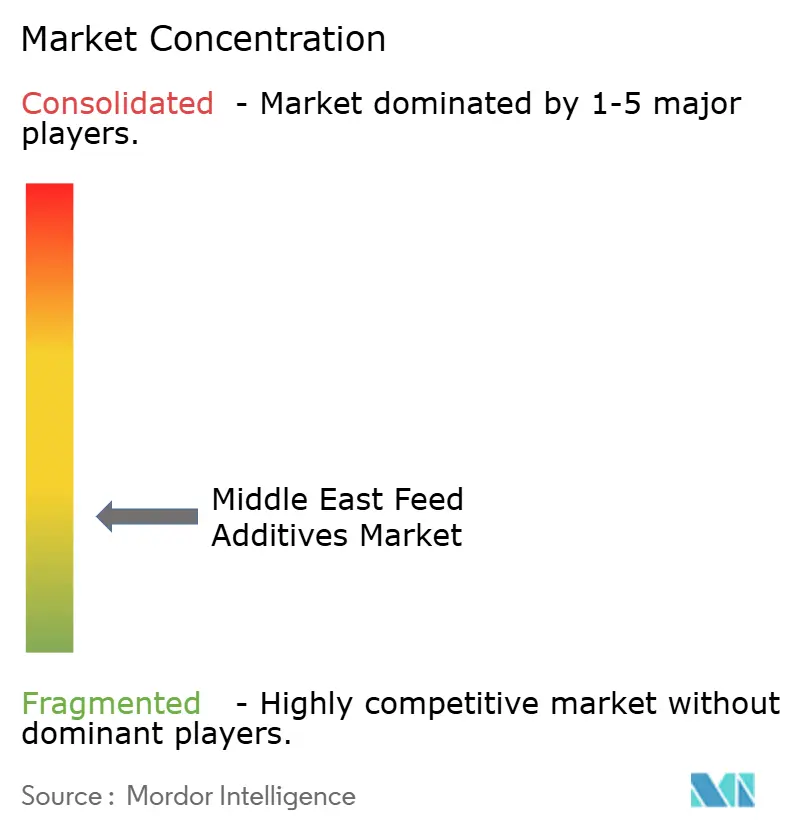
Recent Industry Developments
- February 2025: Novonesis acquired DSM-Firmenich’s share in Feed Enzyme Alliance for EUR 1.5 billion (USD 1.6 billion), consolidating global enzyme capacity and strengthening Middle East distribution.
- January 2025: Turkey-Iran Agricultural Cooperation Meeting outlined joint feed-industry ventures that expedite technology transfer and specialty additive adoption.
- November 2024: Phibro Animal Health completed its acquisition of Zoetis’ medicated feed additive business, expanding its portfolio of gut health and coccidiosis solutions. This move strengthens Phibro’s presence in the Middle East, supporting regional demand for advanced livestock nutrition and antibiotic alternatives.
- September 2024: DSM-Firmenich established a premix and feed additives manufacturing facility in Egypt to serve the Middle East and African markets. The plant provides regional access to animal nutrition products, including vitamins, enzymes, and specialty additives.
Middle East Feed Additives Market Report Scope
Acidifiers, Amino Acids, Antibiotics, Antioxidants, Binders, Enzymes, Flavors & Sweeteners, Minerals, Mycotoxin Detoxifiers, Phytogenics, Pigments, Prebiotics, Probiotics, Vitamins, Yeast are covered as segments by Additive. Aquaculture, Poultry, Ruminants, Swine are covered as segments by Animal. Iran, Saudi Arabia are covered as segments by Country.| Acidifiers | Fumaric Acid |
| Lactic Acid | |
| Propionic Acid | |
| Other Acidifiers | |
| Amino Acids | Lysine |
| Methionine | |
| Threonine | |
| Tryptophan | |
| Other Amino Acids | |
| Antibiotics | Bacitracin |
| Penicillins | |
| Tetracyclines | |
| Tylosin | |
| Other Antibiotics | |
| Antioxidants | Butylated Hydroxyanisole |
| Butylated Hydroxytoluene | |
| Citric Acid | |
| Ethoxyquin | |
| Propyl Gallate | |
| Tocopherols | |
| Other Antioxidants | |
| Binders | Natural Binders |
| Synthetic Binders | |
| Enzymes | Carbohydrases |
| Phytases | |
| Other Enzymes | |
| Flavors and Sweeteners | Flavors |
| Sweeteners | |
| Minerals | Macrominerals |
| Microminerals | |
| Mycotoxin Detoxifiers | Binders |
| Biotransformers | |
| Phytogenics | Essential Oil |
| Herbs and Spices | |
| Other Phytogenics | |
| Pigments | Carotenoids |
| Curcumin and Spirulina | |
| Prebiotics | Fructo Oligosaccharides |
| Galacto Oligosaccharides | |
| Inulin | |
| Lactulose | |
| Mannan Oligosaccharides | |
| Xylo Oligosaccharides | |
| Other Prebiotics | |
| Probiotics | Bifidobacteria |
| Enterococcus | |
| Lactobacilli | |
| Pediococcus | |
| Streptococcus | |
| Other Probiotics | |
| Vitamins | Vitamin A |
| Vitamin B | |
| Vitamin C | |
| Vitamin E | |
| Other Vitamins | |
| Yeast | Live Yeast |
| Selenium Yeast | |
| Spent Yeast | |
| Torula Dried Yeast | |
| Whey Yeast | |
| Yeast Derivatives |
| Aquaculture | Fish |
| Shrimp | |
| Other Aquaculture Species | |
| Poultry | Broiler |
| Layer | |
| Other Poultry Birds | |
| Ruminants | Beef Cattle |
| Dairy Cattle | |
| Other Ruminants | |
| Swine | |
| Other Animals |
| Iran |
| Saudi Arabia |
| Rest of Middle East |
| By Additive | Acidifiers | Fumaric Acid |
| Lactic Acid | ||
| Propionic Acid | ||
| Other Acidifiers | ||
| Amino Acids | Lysine | |
| Methionine | ||
| Threonine | ||
| Tryptophan | ||
| Other Amino Acids | ||
| Antibiotics | Bacitracin | |
| Penicillins | ||
| Tetracyclines | ||
| Tylosin | ||
| Other Antibiotics | ||
| Antioxidants | Butylated Hydroxyanisole | |
| Butylated Hydroxytoluene | ||
| Citric Acid | ||
| Ethoxyquin | ||
| Propyl Gallate | ||
| Tocopherols | ||
| Other Antioxidants | ||
| Binders | Natural Binders | |
| Synthetic Binders | ||
| Enzymes | Carbohydrases | |
| Phytases | ||
| Other Enzymes | ||
| Flavors and Sweeteners | Flavors | |
| Sweeteners | ||
| Minerals | Macrominerals | |
| Microminerals | ||
| Mycotoxin Detoxifiers | Binders | |
| Biotransformers | ||
| Phytogenics | Essential Oil | |
| Herbs and Spices | ||
| Other Phytogenics | ||
| Pigments | Carotenoids | |
| Curcumin and Spirulina | ||
| Prebiotics | Fructo Oligosaccharides | |
| Galacto Oligosaccharides | ||
| Inulin | ||
| Lactulose | ||
| Mannan Oligosaccharides | ||
| Xylo Oligosaccharides | ||
| Other Prebiotics | ||
| Probiotics | Bifidobacteria | |
| Enterococcus | ||
| Lactobacilli | ||
| Pediococcus | ||
| Streptococcus | ||
| Other Probiotics | ||
| Vitamins | Vitamin A | |
| Vitamin B | ||
| Vitamin C | ||
| Vitamin E | ||
| Other Vitamins | ||
| Yeast | Live Yeast | |
| Selenium Yeast | ||
| Spent Yeast | ||
| Torula Dried Yeast | ||
| Whey Yeast | ||
| Yeast Derivatives | ||
| By Animal | Aquaculture | Fish |
| Shrimp | ||
| Other Aquaculture Species | ||
| Poultry | Broiler | |
| Layer | ||
| Other Poultry Birds | ||
| Ruminants | Beef Cattle | |
| Dairy Cattle | ||
| Other Ruminants | ||
| Swine | ||
| Other Animals | ||
| By Geography | Iran | |
| Saudi Arabia | ||
| Rest of Middle East | ||
Market Definition
- FUNCTIONS - For the study, feed additives are considered to be commercially manufactured products that are used to enhance characteristics such as weight gain, feed conversion ratio, and feed intake when fed in appropriate proportions.
- RESELLERS - Companies engaged in reselling feed additives without value addition have been excluded from the market scope, to avoid double counting.
- END CONSUMERS - Compound feed manufacturers are considered to be end-consumers in the market studied. The scope excludes farmers buying feed additives to be used directly as supplements or premixes.
- INTERNAL COMPANY CONSUMPTION - Companies engaged in the production of compound feed as well as the manufacturing of feed additives are part of the study. However, while estimating the market sizes, the internal consumption of feed additives by such companies has been excluded.
| Keyword | Definition |
|---|---|
| Feed additives | Feed additives are products used in animal nutrition for purposes of improving the quality of feed and the quality of food from animal origin, or to improve the animals’ performance and health. |
| Probiotics | Probiotics are microorganisms introduced into the body for their beneficial qualities. (It maintains or restores beneficial bacteria to the gut). |
| Antibiotics | Antibiotic is a drug that is specifically used to inhibit the growth of bacteria. |
| Prebiotics | A non-digestible food ingredient that promotes the growth of beneficial microorganisms in the intestines. |
| Antioxidants | Antioxidants are compounds that inhibit oxidation, a chemical reaction that produces free radicals. |
| Phytogenics | Phytogenics are a group of natural and non-antibiotic growth promoters derived from herbs, spices, essential oils, and oleoresins. |
| Vitamins | Vitamins are organic compounds, which are required for normal growth and maintenance of the body. |
| Metabolism | A chemical process that occurs within a living organism in order to maintain life. |
| Amino acids | Amino acids are the building blocks of proteins and play an important role in metabolic pathways. |
| Enzymes | Enzyme is a substance that acts as a catalyst to bring about a specific biochemical reaction. |
| Anti-microbial resistance | The ability of a microorganism to resist the effects of an antimicrobial agent. |
| Anti-microbial | Destroying or inhibiting the growth of microorganisms. |
| Osmotic balance | It is a process of maintaining salt and water balance across membranes within the body's fluids. |
| Bacteriocin | Bacteriocins are the toxins produced by bacteria to inhibit the growth of similar or closely related bacterial strains. |
| Biohydrogenation | It is a process that occurs in the rumen of an animal in which bacteria convert unsaturated fatty acids (USFA) to saturated fatty acids (SFA). |
| Oxidative rancidity | It is a reaction of fatty acids with oxygen, which generally causes unpleasant odors in animals. To prevent these, antioxidants were added. |
| Mycotoxicosis | Any condition or disease caused by fungal toxins, mainly due to contamination of animal feed with mycotoxins. |
| Mycotoxins | Mycotoxins are toxin compounds that are naturally produced by certain types of molds (fungi). |
| Feed Probiotics | Microbial feed supplements positively affect gastrointestinal microbial balance. |
| Probiotic yeast | Feed yeast (single-cell fungi) and other fungi used as probiotics. |
| Feed enzymes | They are used to supplement digestive enzymes in an animal’s stomach to break down food. Enzymes also ensure that meat and egg production is improved. |
| Mycotoxin detoxifiers | They are used to prevent fungal growth and to stop any harmful mold from being absorbed in the gut and blood. |
| Feed antibiotics | They are used both for the prevention and treatment of diseases but also for rapid growth and development. |
| Feed antioxidants | They are used to protect the deterioration of other feed nutrients in the feed such as fats, vitamins, pigments, and flavoring agents, thus providing nutrient security to the animals. |
| Feed phytogenics | Phytogenics are natural substances, added to livestock feed to promote growth, aid in digestion, and act as anti-microbial agents. |
| Feed vitamins | They are used to maintain the normal physiological function and normal growth and development of animals. |
| Feed flavors and sweetners | These flavors and sweeteners help to mask tastes and odors during changes in additives or medications and make them ideal for animal diets undergoing transition. |
| Feed acidifiers | Animal feed acidifiers are organic acids incorporated into the feed for nutritional or preservative purposes. Acidifiers enhance congestion and microbiological balance in the alimentary and digestive tracts of livestock. |
| Feed minerals | Feed minerals play an important role in the regular dietary requirements of animal feed. |
| Feed binders | Feed binders are the binding agents used in the manufacture of safe animal feed products. It enhances the taste of food and prolongs the storage period of the feed. |
| Key Terms | Abbreviation |
| LSDV | Lumpy Skin Disease Virus |
| ASF | African Swine Fever |
| GPA | Growth Promoter Antibiotics |
| NSP | Non-Starch Polysaccharides |
| PUFA | Polyunsaturated Fatty Acid |
| Afs | Aflatoxins |
| AGP | Antibiotic Growth Promoters |
| FAO | The Food And Agriculture Organization of the United Nations |
| USDA | The United States Department of Agriculture |
Research Methodology
Mordor Intelligence follows a four-step methodology in all our reports.
- Step-1: IDENTIFY KEY VARIABLES: In order to build a robust forecasting methodology, the variables and factors identified in Step-1 are tested against available historical market numbers. Through an iterative process, the variables required for market forecast are set and the model is built on the basis of these variables.
- Step-2: Build a Market Model: Market-size estimations for the forecast years are in nominal terms. Inflation is not a part of the pricing, and the average selling price (ASP) is kept constant throughout the forecast period.
- Step-3: Validate and Finalize: In this important step, all market numbers, variables and analyst calls are validated through an extensive network of primary research experts from the market studied. The respondents are selected across levels and functions to generate a holistic picture of the market studied.
- Step-4: Research Outputs: Syndicated Reports, Custom Consulting Assignments, Databases & Subscription Platforms
